Magnetic Properties of Li3V2(PO4)3/Li3PO4 Composite
Abstract
:1. Introduction
2. Experimental
2.1. Sample Synthesis and Characterization
2.2. Experimental Details
3. Results and Discussion
3.1. Magnetization
3.2. Electron Spin Resonance
4. Conclusions
Author Contributions
Funding
Data Availability Statement
Conflicts of Interest
References
- Li, W.; Song, B.; Manthiram, A. High-voltage positive electrode materials for lithium-ion batteries. Chem. Soc. Rev. 2017, 46, 3006–3059. [Google Scholar] [CrossRef] [PubMed]
- Hu, M.; Pang, X.; Zhou, Z. Recent progress in high-voltage lithium ion batteries. J. Power Sources 2013, 237, 229–242. [Google Scholar] [CrossRef]
- Liu, C.; Massé, R.; Nan, X.; Cao, G. A promising cathode for Li-ion batteries: Li3V2(PO4)3. Energy Storage Mater. 2016, 4, 15–58. [Google Scholar] [CrossRef] [Green Version]
- Rui, X.; Yan, Q.; Skyllas-Kazacos, M.; Lim, T.M. Li3V2(PO4)3 cathode materials for lithium-ion batteries: A review. J. Power Sources 2014, 258, 19–38. [Google Scholar] [CrossRef]
- Tan, H.; Xu, L.; Geng, H.; Rui, X.; Li, C.; Huang, S. Nanostructured Li3V2(PO4)3 Cathodes. Small 2018, 14, 1800567. [Google Scholar] [CrossRef]
- Liao, Y.; Li, C.; Lou, X.; Hu, X.; Ning, Y.; Yuan, F.; Chen, B.; Shen, M.; Hu, B. Carbon-coated Li3V2(PO4)3 derived from metal-organic framework as cathode for lithium-ion batteries with high stability. Electrochim. Acta 2018, 271, 608–616. [Google Scholar] [CrossRef]
- Chen, Y.; Xiang, K.; Zhu, Y.; Xiao, L.; Chen, W.; Chen, X.; Chen, H. Bio-template fabrication of nitrogen-doped Li3V2(PO4)3/carbon composites from cattail fibers and their high-rate performance in lithium-ion batteries. J. Alloy. Compd. 2019, 782, 89–99. [Google Scholar] [CrossRef]
- Ding, X.-K.; Zhang, L.-L.; Yang, X.-L.; Fang, H.; Zhou, Y.-X.; Wang, J.-Q.; Ma, D. Anthracite-Derived Dual-Phase Carbon-Coated Li3V2(PO4)3 as High-Performance Cathode Material for Lithium Ion Batteries. ACS Appl. Mater. Interfaces 2017, 9, 42788–42796. [Google Scholar] [CrossRef]
- Ren, M.M.; Zhou, Z.; Gao, X.P.; Peng, W.X.; Wei, J.P. Core-Shell Li3V2(PO4)3@C Composites as Cathode Materials for Lithium-Ion Batteries. J. Phys. Chem. C 2008, 112, 5689–5693. [Google Scholar] [CrossRef]
- Wang, J.; Liu, J.; Yang, G.; Zhang, X.; Yan, X.; Pan, X.; Wang, R. Electrochemical performance of Li3V2(PO4)3/C cathode material using a novel carbon source. Electrochim. Acta 2009, 54, 6451–6454. [Google Scholar] [CrossRef]
- Zhang, L.L.; Liang, G.; Peng, G.; Zou, F.; Huang, Y.H.; Croft, M.C.; Ignatov, A. Significantly improved electrochemical performance in Li3V2(PO4)3/C promoted by SiO2 coating for lithium-ion batteries. J. Phys. Chem. C 2012, 116, 12401–12408. [Google Scholar] [CrossRef]
- Lai, C.Y.; Wei, J.J.; Wang, Z.; Xu, Q.J.; Lu, Y.F.; Li, H.X. Li3V2(PO4)3/(SiO2 + C) composite with better stability and electrochemical properties for lithium ion batteries. Solid State Ion. 2015, 272, 121–126. [Google Scholar] [CrossRef]
- Sun, H.-B.; Zhou, Y.-H.; Zhang, L.-L.; Yang, X.-L.; Cao, X.-Z.; Arave, H.; Fang, H.; Liang, G. Investigations on Zr incorporation into Li3V2(PO4)3/C cathode materials for lithium ion batteries. Phys. Chem. Chem. Phys. 2017, 19, 5155–5162. [Google Scholar] [CrossRef]
- Ren, M.; Zhou, Z.; Li, Y.; Gao, X.P.; Yan, J. Preparation and electrochemical studies of Fe-doped Li3V2(PO4)3 cathode materials for lithium-ion batteries. J. Power Sources 2006, 162, 1357–1362. [Google Scholar] [CrossRef]
- Ivanishchev, A.V.; Ushakov, A.V.; Ivanishcheva, I.A.; Churikov, A.V.; Mironov, A.V.; Fedotov, S.S.; Khasanova, N.R.; Antipov, E.V. Structural and electrochemical study of fast Li diffusion in Li3V2(PO4)3-based electrode material. Electrochim. Acta 2017, 230, 479–491. [Google Scholar] [CrossRef]
- Gavrilova, T.P.; Khantimerov, S.M.; Fatykhov, R.R.; Yatsyk, I.V.; Cherosov, M.A.; Lee, H.S.; Vishwanathan, R.; Saravanan, K.; Suleimanov, N.M. Magnetic properties and vanadium oxidation state in α-Li3V2(PO4)3/C composite: Magnetization and ESR measurements. Solid State Commun. 2021, 323, 114108. [Google Scholar] [CrossRef]
- Park, M.; Zhang, X.; Chung, M.; Less, G.B.; Sastry, A.M. A review of conduction phenomena in Li-ion batteries. J. Power Sources 2010, 195, 7904–7929. [Google Scholar] [CrossRef]
- Zhou, F.; Kang, K.; Maxisch, T.; Ceder, G.; Morgan, D. The electronic structure and band gap of LiFePO4 and LiMnPO4. Solid State Commun. 2004, 132, 181–186. [Google Scholar] [CrossRef] [Green Version]
- Yin, S.-C.; Strobel, P.S.; Grondey, H.; Nazar, L.F. Li2.5V2(PO4)3: A Room-Temperature Analogue to the Fast-Ion Conducting High-Temperature γ-Phase of Li3V2(PO4)3. Chem. Mater. 2004, 16, 1456–1465. [Google Scholar] [CrossRef]
- Tai, Z.; Zhu, W.; Shi, M.; Xin, Y.; Guo, S.; Wu, Y.; Chen, Y.; Liu, Y. Improving electrochemical performances of Lithium-rich oxide by cooperatively doping Cr and coating Li3PO4 as cathode material for Lithium-ion batteries. J. Colloid Interface Sci. 2020, 576, 468–475. [Google Scholar] [CrossRef]
- Zhang, W.; Liang, L.; Zhao, F.; Liu, Y.; Hou, L.; Yuan, C. Ni-rich LiNi0.8Co0.1Mn0.1O2 coated with Li-ion conductive Li3PO4 as competitive cathodes for high-energy-density lithium ion batteries. Electrochim. Acta 2020, 340, 135871. [Google Scholar] [CrossRef]
- Wang, Y.; Zhang, X.; He, W.; Wei, C.; Cheng, Q. A review for the synthesis methods of lithium vanadium phosphate cathode materials. J. Mater. Sci. Mater. Electron. 2017, 28, 18269–18295. [Google Scholar] [CrossRef]
- Lee, H.S.; Vishwanathan, R.; Saravanan, K.; Nagarathinam, M.; Law, M.; Wang, C.; Tripathi, A.; Palani, B. Key design considerations for synthesis of mesoporous α-Li3V2(PO4)3/C for high power lithium batteries. Electrochim. Acta 2021, 372, 137831. [Google Scholar] [CrossRef]
- Saravanan, K.; Mason, C.W.; Rudola, A.; Wong, K.H.; Balaya, P. The first report on excellent cycling stability and superior rate capability of Na3V2(PO4)3 for Sodium-ion batteries. Adv. Energy Mater. 2013, 3, 444–450. [Google Scholar] [CrossRef]
- Du, K.; Wang, C.; Subasinghe, L.U.; Gajjela, S.R.; Law, M.; Rudola, A.; Balaya, P. A Comprehensive Study on the Electrolyte, Anode and Cathode for Developing Commercial Type Non-flammable Sodium-ion Battery. Energy Storage Mater. 2020, 29, 287–299. [Google Scholar] [CrossRef]
- Nizamov, F.A.; Togulev, P.N.; Abdullin, D.R.; Khantimerov, S.M.; Balaya, P.; Suleimanov, N.M. Antisite Defects and Valence State of Vanadium in Na3V2(PO4)3. Phys. Solid State 2016, 58, 475–480. [Google Scholar] [CrossRef]
- Yang, G.; Ji, H.; Liu, H.; Qian, B.; Jiang, X. Crystal structure and electrochemical performance of Li3V2(PO4)3 synthesized by optimized microwave solid-state synthesis route. Electrochim. Acta 2010, 55, 3669–3680. [Google Scholar] [CrossRef]
- Patoux, S.; Wurm, C.; Morcrette, M.; Rousse, G.; Masquelier, C. A comparative structural and electrochemical study of monoclinic Li3Fe2(PO4)3 and Li3V2(PO4)3. J. Power Sources 2003, 119–121, 278–284. [Google Scholar] [CrossRef]
- Liu, H.; Yang, G.; Zhang, X.; Gao, P.; Wang, L.; Fang, J.; Pinto, J.; Jiang, X. Kinetics of conventional carbon coated-Li3V2(PO4)3 and nanocomposite Li3V2(PO4)3/graphene as cathode materials for lithium ion batteries. J. Mater. Chem. 2012, 22, 11039–11047. [Google Scholar] [CrossRef]
- Cao, X.; Wu, H.; Ge, P.; Zhao, Y.; Zhu, L.; Liu, F.; Wang, J. Synthesis of Li3V2(PO4)3/C Composites as Cathode Materials for Lithium Ion Batteries via a Sol-Gel Method. Int. J. Electrochem. Sci. 2015, 10, 2997–3009. [Google Scholar]
- Chen, Y.; Zhang, D.; Bian, X.; Bie, X.; Wang, C.; Du, F.; Jang, M.; Chen, G.; Wei, Y. Characterizations of the electrode/electrolyte interfacial properties of carbon coated Li3V2(PO4)3 cathode material in LiPF6 based electrolyte. Electrochim. Acta 2012, 79, 95–101. [Google Scholar] [CrossRef]
- Yin, S.-C.; Grondey, H.; Strobel, P.; Anne, M.; Nazar, L.F. Electrochemical Property: Structure Relationships in Monoclinic Li3-yV2(PO4)3. J. Am. Chem. Soc. 2003, 125, 10402–10411. [Google Scholar] [CrossRef] [PubMed]
- EasySpin. Available online: http://www.easyspin.org (accessed on 1 February 2021).
- Cahill, L.S.; Chapman, R.P.; Kirby, C.W.; Goward, G.R. The Challenge of Paramagnetism in Two-Dimensional 6,7Li Exchange NMR. Appl. Magn. Reson. 2007, 32, 565–581. [Google Scholar] [CrossRef]
- De Gennes, P.G. Effects of Double Exchange in Magnetic Crystals. Phys. Rev. 1960, 118, 141–154. [Google Scholar] [CrossRef]
- Heikes, R.R.; McGuire, T.R.; Happel, R.G. Role of Double Exchange in the Magnetic Structure of LixMn1−xSe. Phys. Rev. 1961, 121, 703–707. [Google Scholar] [CrossRef]
- Pickart, S.J.; Nathans, R.; Shirane, G. Magnetic Structure Transitions in LixMn1−xSe. Phys. Rev. 1961, 121, 707–714. [Google Scholar] [CrossRef]
- Eremina, R.M.; Gavrilova, T.P.; Yatsyk, I.V.; Zaripov, R.B.; Sukhanov, A.A.; Shustov, V.A.; Lyadov, N.M.; Chichkov, V.I.; Andreev, N.V. Magnetic Resonance Investigations of h-YbMnO3. Appl. Magn. Reson. 2016, 47, 869–879. [Google Scholar] [CrossRef]
- Bykov, E.O.; Gavrilova, T.P.; Yatsyk, I.V.; Gilmutdinov, I.F.; Parfenov, V.V.; Kurbakov, A.I.; Eremina, R.M. Structural and magnetic properties of Yb1−xSrxMnO3. Ceram. Int. 2019, 45, 10286–10294. [Google Scholar] [CrossRef]
- Gavrilova, T.P.; Yagfarova, A.R.; Deeva, Y.A.; Yatsyk, I.V.; Gilmutdinov, I.F.; Cherosov, M.A.; Vagizov, F.G.; Chupakhina, T.I.; Eremina, R.M. Iron oxidation state in La0.7Sr1.3Fe0.7Ti0.3O4 and La0.5Sr1.5Fe0.5Ti0.5O4 layered perovskites: Magnetic properties. J. Phys. Chem. Solids 2021, 153, 109994. [Google Scholar] [CrossRef]
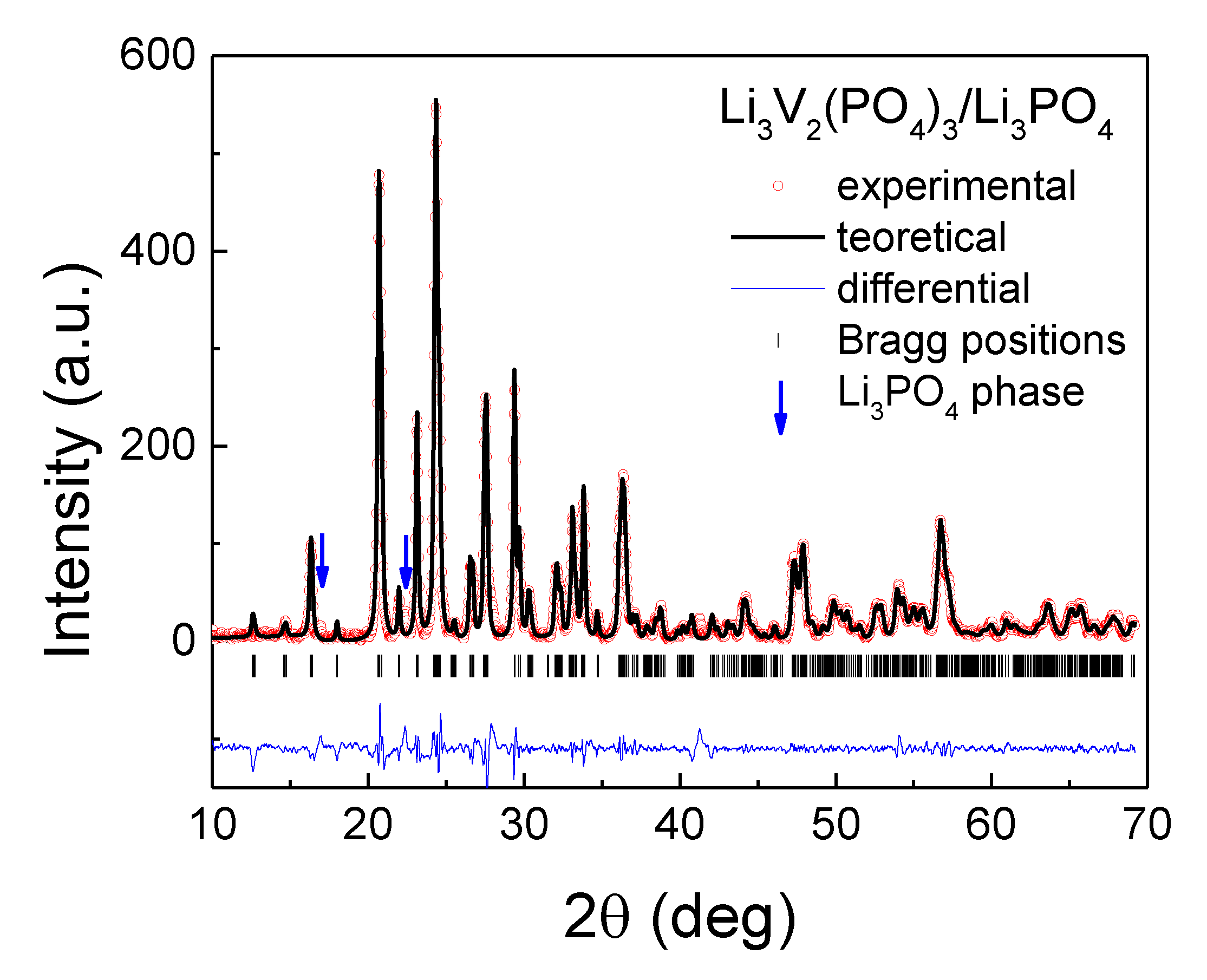
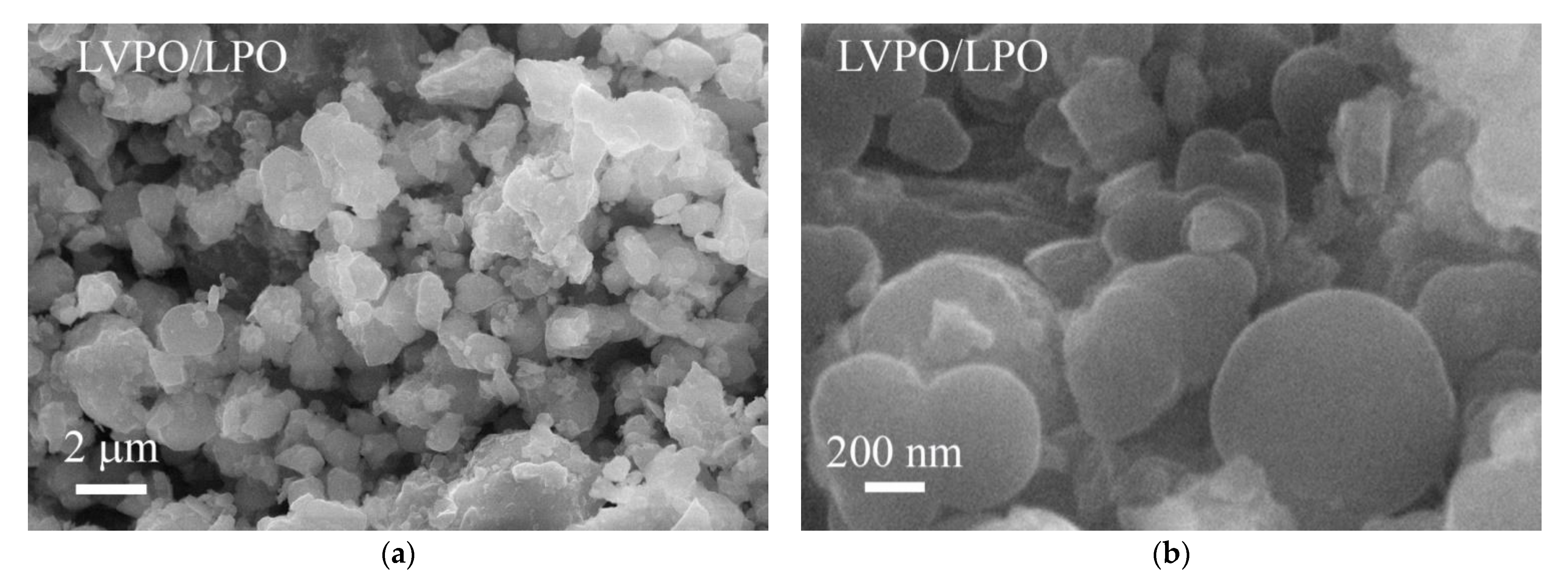

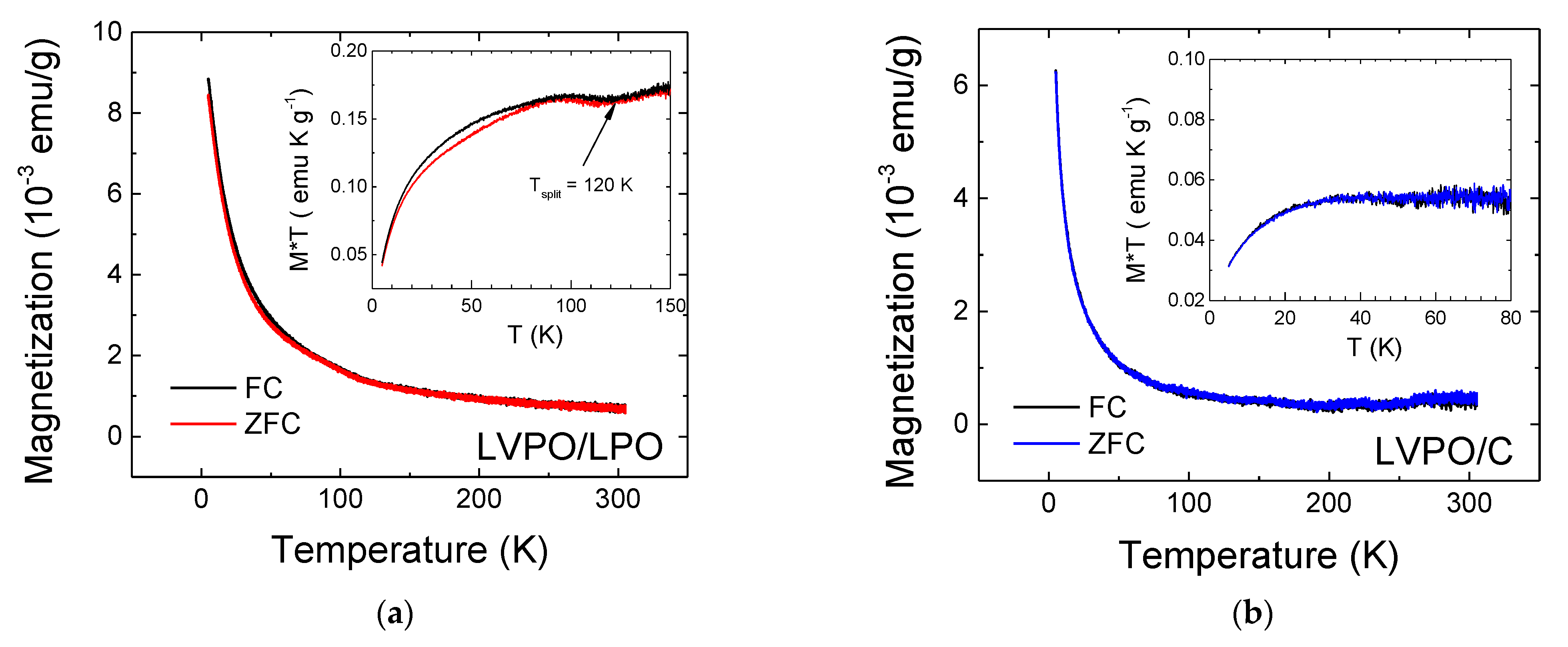
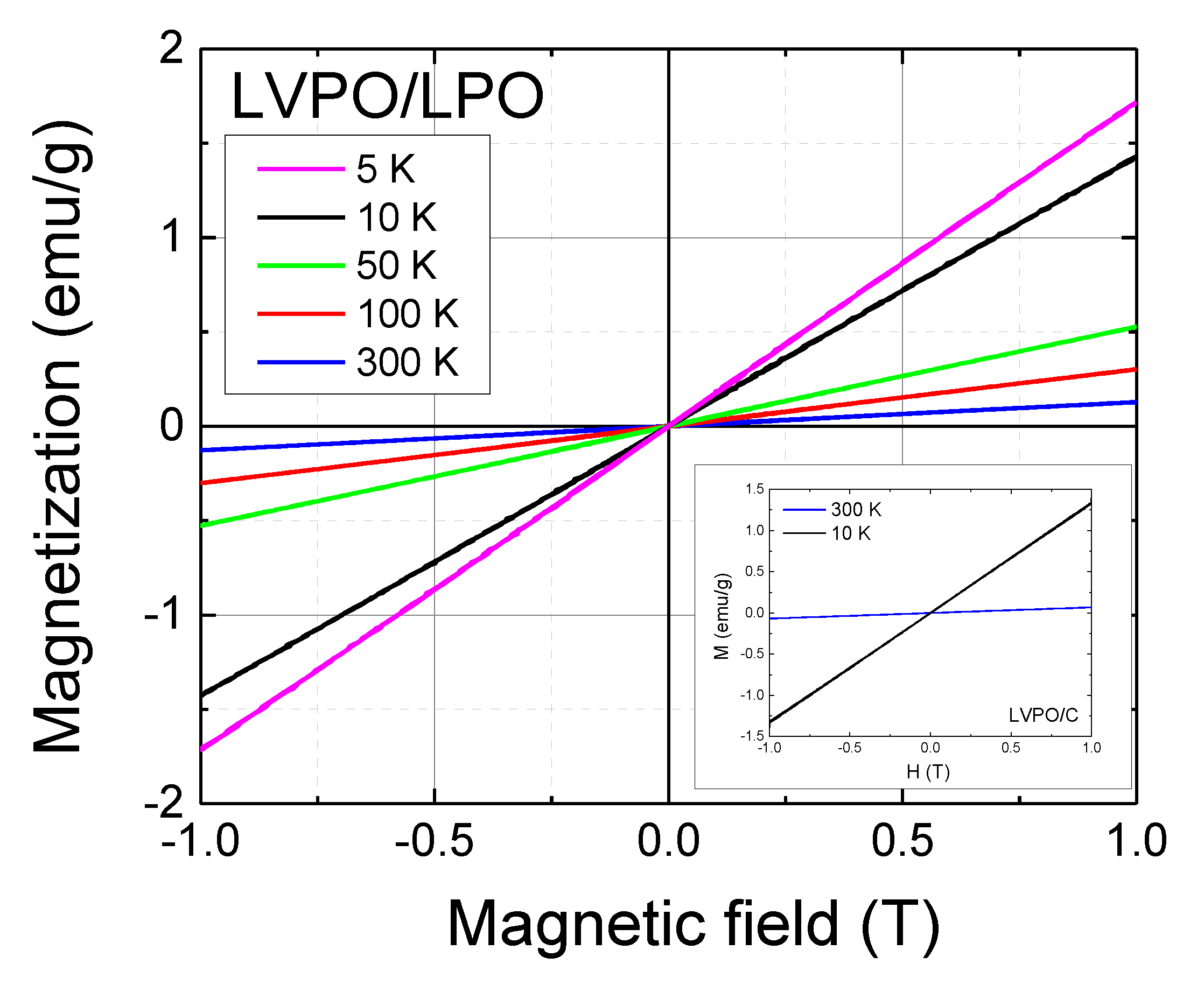
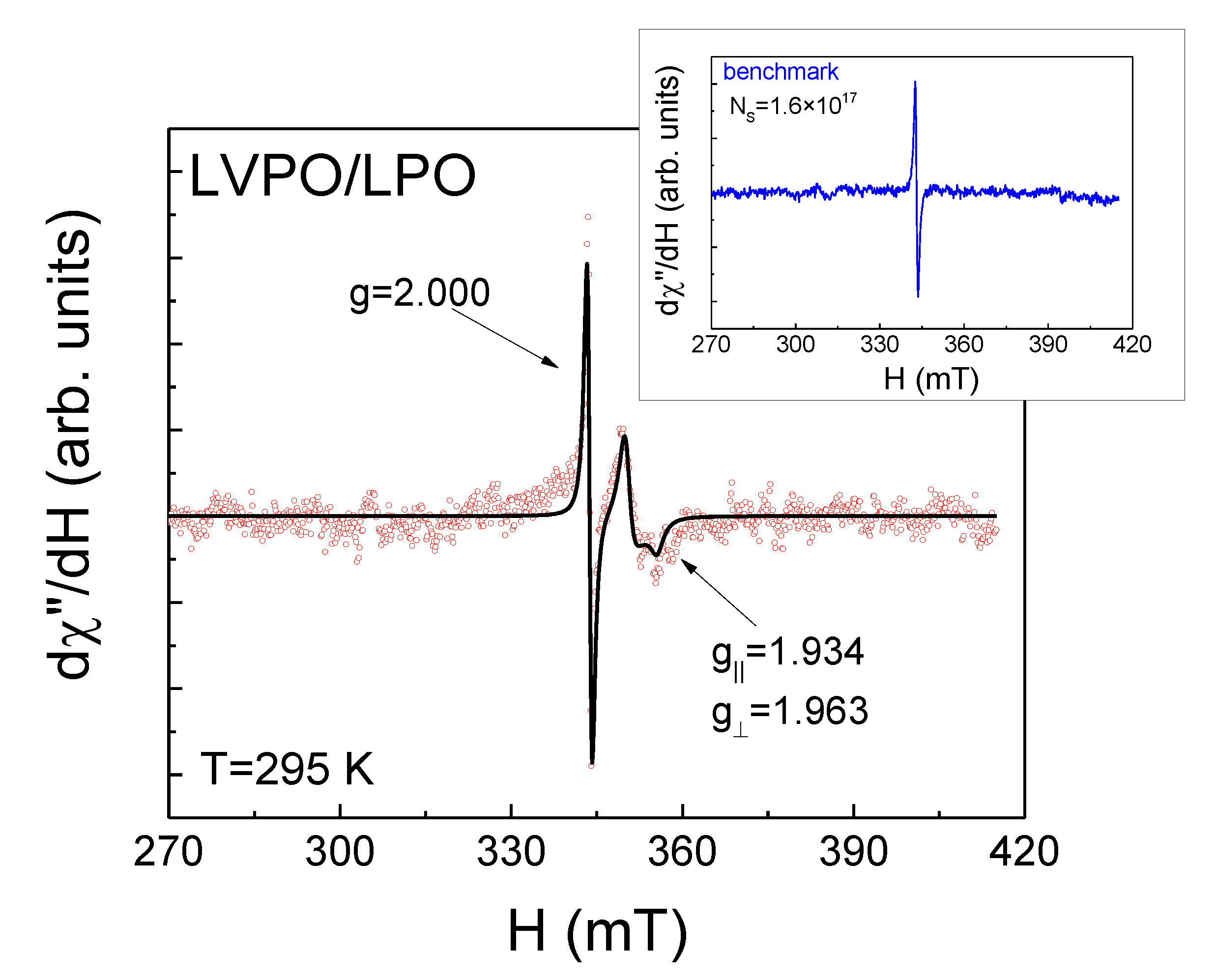
Publisher’s Note: MDPI stays neutral with regard to jurisdictional claims in published maps and institutional affiliations. |
© 2021 by the authors. Licensee MDPI, Basel, Switzerland. This article is an open access article distributed under the terms and conditions of the Creative Commons Attribution (CC BY) license (https://creativecommons.org/licenses/by/4.0/).
Share and Cite
Gavrilova, T.; Khantimerov, S.; Cherosov, M.; Batulin, R.; Lyadov, N.; Yatsyk, I.; Deeva, Y.; Turkin, D.; Chupakhina, T.; Suleimanov, N. Magnetic Properties of Li3V2(PO4)3/Li3PO4 Composite. Magnetochemistry 2021, 7, 64. https://doi.org/10.3390/magnetochemistry7050064
Gavrilova T, Khantimerov S, Cherosov M, Batulin R, Lyadov N, Yatsyk I, Deeva Y, Turkin D, Chupakhina T, Suleimanov N. Magnetic Properties of Li3V2(PO4)3/Li3PO4 Composite. Magnetochemistry. 2021; 7(5):64. https://doi.org/10.3390/magnetochemistry7050064
Chicago/Turabian StyleGavrilova, Tatiana, Sergey Khantimerov, Mikhail Cherosov, Ruslan Batulin, Nickolay Lyadov, Ivan Yatsyk, Yulia Deeva, Denis Turkin, Tatiana Chupakhina, and Nail Suleimanov. 2021. "Magnetic Properties of Li3V2(PO4)3/Li3PO4 Composite" Magnetochemistry 7, no. 5: 64. https://doi.org/10.3390/magnetochemistry7050064
APA StyleGavrilova, T., Khantimerov, S., Cherosov, M., Batulin, R., Lyadov, N., Yatsyk, I., Deeva, Y., Turkin, D., Chupakhina, T., & Suleimanov, N. (2021). Magnetic Properties of Li3V2(PO4)3/Li3PO4 Composite. Magnetochemistry, 7(5), 64. https://doi.org/10.3390/magnetochemistry7050064





